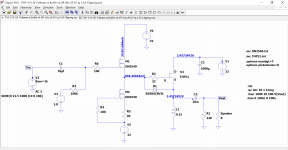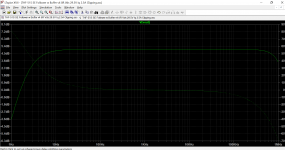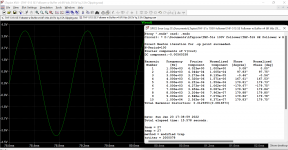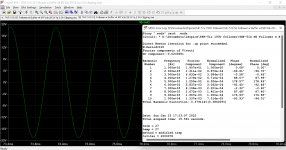Yes, the DC coupling is intentional, the bias is set at the input of the JFET buffer. ZM had mentioned some pages back he took this approach to avoid issues with gate current / bias drift. I've done similar in tube circuits with DC-coupled cathode followers - bias at the input of the CF to set the output operating point and drive the tube grid in A2. And if you have capacitor phobia, one less cap in the signal path 🙂 if both the tube and VFET stages are put in the same chassis, a heater winding could be used for the bias supply, which is convenient.
Won't that zener limit the positive waveform too early?
It is borderline, any smaller and it would be a problem, but certainly could use more wiggle room, will increase it in the final, 15 or 18V.
SWEEET! Looks a bit like the positive half of the SuSy T. PuckFo, even the tube is a relative of the 6SN7 I am planning to use.Right now I am looking at doing a tube front end, followed by a JFET buffer, then THF-51S final.
You may consider a way to adjust the THF51 gate bias voltage for a real-world build.
Don't think so. The THF51 is configured as a source follower, so the source voltage will always be close to the gate voltage.Won't that zener limit the positive waveform too early?
Last edited:
I see it now. Yes, it is a cunning plan. Let the JFET buffer supply any gate leakage current to the big SIT.Yes, the DC coupling is intentional, the bias is set at the input of the JFET buffer. ZM had mentioned some pages back he took this approach to avoid issues with gate current / bias drift. I've done similar in tube circuits with DC-coupled cathode followers - bias at the input of the CF to set the output operating point and drive the tube grid in A2. And if you have capacitor phobia, one less cap in the signal path 🙂 if both the tube and VFET stages are put in the same chassis, a heater winding could be used for the bias supply, which is convenient.
SWEEET! Looks a bit like the positive half of the SuSy T. PuckFo, even the tube is a relative of the 6SN7 I am planning to use.
You may consider a way to adjust the THF51 gate bias voltage for a real-world build.
Thanks! Still needs some work. Since the output has no gain, the buffer needs to swing a decent amount of voltage and clips just before the output, the complementary pair is already run near its limit. So perhaps I need to re-evaluate the buffer, or reduce the output bias current for a lower power design. I had originally looked at a common source config which would alleviate that issue and reduce gain needs of the tube stage, but the output impedance is quite high in common source and most seem to prefer common drain.
If I were to do a common source design, might consider something like this - gain requirements for the tube stage are not demanding, so could use step-down transformer coupling between the tube stage and JFET buffer with biasing through the transformer secondary. Voltage swing in the buffer then is low as the extra gain is made up for in the VFET stage. But distortion and output impedance are both significantly higher. My thinking is the common drain version would sound best.
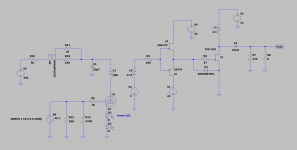

Or bootstrap the buffer F4 style.
Thanks for the idea, I'll look into it!
Don't think so. The THF51 is configured as a source follower, so the source voltage will always be close to the gate voltage.
I was wrong but not for that reason. There is about 4v between gate and source but i missed the negative bias in front of the jfets
source follows gate alwaysWon't that zener limit the positive waveform too early?
zener is protection device
Оne can argue that with a 24v supply for the buffer, there is little the zener achieves apart from sounding bad. Were the Tokins not supposed to take at least -20v at the gate? If i were paranoid i would reduce the buffer's supply to +/-20v and remove the zener.
if you're Chicken as ZM, zener is a must
I'm also blind how zener there results in sounding bad
I'm also blind how zener there results in sounding bad
I definitely prefer common drain for best sound, and would recommend it over common source.If I were to do a common source design, might consider something like this - gain requirements for the tube stage are not demanding, so could use step-down transformer coupling between the tube stage and JFET buffer with biasing through the transformer secondary. Voltage swing in the buffer then is low as the extra gain is made up for in the VFET stage. But distortion and output impedance are both significantly higher. My thinking is the common drain version would sound best.
One possible solution is to use a different device for the buffer. For instance in Michael Rothacher's Luminaria preamp a DN2540 is used for input buffering. I have that in my Luminaria and I am happy with the sound. If I were to build a buffer to handle high voltage signals, I would probably use a DN2540 or similar with a CCS and bipolar power supply. Here is an article that suggests two other devices and also compares them to the DN2540. Probably any one of the three devices would do - just have to play around with the voltages and current a bit. Unfortunately two of the three are hard to get right now:
Buffers
I definitely prefer common drain for best sound, and would recommend it over common source.
One possible solution is to use a different device for the buffer. For instance in Michael Rothacher's Luminaria preamp a DN2540 is used for input buffering. I have that in my Luminaria and I am happy with the sound. If I were to build a buffer to handle high voltage signals, I would probably use a DN2540 or similar with a CCS and bipolar power supply. Here is an article that suggests two other devices and also compares them to the DN2540. Probably any one of the three devices would do - just have to play around with the voltages and current a bit. Unfortunately two of the three are hard to get right now:
Buffers
Thanks Ben, I was thinking the same, going with a beefier buffer could be the easiest way. I only went with the 2SK170/2SJ74 due to their reputation for good sound. I'm going to explore some options over the next week or so. Oddly enough, I have a small stash of IXTP08N100D2 as well as TO-92-3 and TO-220 DN2540. Also should have a few AOT1N60 around, another popular buffer MOSFET. Might have a pair of Cree C2M1000170D too, I was doing a lot of experimentation with tube > source follower circuits at one time. I didn't realize the IXYS parts were becoming scarce, especially my favorite, the IXCP10M45S! This might be a problem for some other projects I have ongoing...let me do some research / run some sims and come up with some ideas for an alternative buffer.
Last edited:
I don't think choosing a Mosfet for the buffer will be an issue. You will be "hearing" the triode gain stage over it anyways.
At some point I will build a stand-alone voltage gain stage and I will most likely use the DN2540 or something similar for the buffer.
I did some LTSpicing and it is doable. Actual THD will most likely be higher.
At some point I will build a stand-alone voltage gain stage and I will most likely use the DN2540 or something similar for the buffer.
I did some LTSpicing and it is doable. Actual THD will most likely be higher.
Attachments
What are you planning to use for your gain stage? The DN2540 buffer looks good. In a hybrid triode / source follower MOSFET headphone amp I designed, I did find that changing MOSFET buffer devices did change the character of the amplifier to a noticeable extent, specifically going between the AOT1N60 and C2M1000170D. The Cree SiC FET does need special care as it is prone to oscillation, but it was preferred between the two. I use the DN2540 with triodes as a hybrid mu follower frequently, the sound is always good.
I am using a Luminaria preamp. I have 102 dB sensitive speakers so the Luminaria provides enough voltage to my follower amps to power my speakers to acceptable levels. It doesn't have enough voltage to power my common drain THF-51S Mu-follower to its 50W maximum output but my speakers do not need the 50W. I will probably build a gain stage just so that I can have the full 50W available, and for the fun of building something.
I have been working with a set of front end cards designed for the recent VFET amps. Mine is the P-channel version, but they work the same for the N-channel version. Two of these in particular are suitable for use with other unity gain followers running from single-rail power supplies. These are the Dreadnought and Marauder designs from Mark Johnson. They both use on-board DC-DC converters to generate an internal ~58V boosted power rail to supply either a discrete or opamp based gain stage.
While they were originally designed to work with the 36V PSU of the VFET amp, I have found some simple tweaks that let them run from a slightly lower input voltage, say 28V to 32V and still generate 55V to 60V for the boosted rail. The common drain, choke loaded SIT follower being discussed was exactly the type of target amp I had in mind for this modification.
Both of these FE cards sound great with my VFET amp. I plan on building my own 2SK180 common drain follower with one of these for the FE gain.
While they were originally designed to work with the 36V PSU of the VFET amp, I have found some simple tweaks that let them run from a slightly lower input voltage, say 28V to 32V and still generate 55V to 60V for the boosted rail. The common drain, choke loaded SIT follower being discussed was exactly the type of target amp I had in mind for this modification.
Both of these FE cards sound great with my VFET amp. I plan on building my own 2SK180 common drain follower with one of these for the FE gain.
My Luminaria is resistor loaded with a 150V power supply so it is not capable of output voltage for 50W, but choke loading would do it. However I like the way the Luminaria sounds with resistor loading so I do not want to change it to choke loading. I also do not want to keep the resistor load and raise the power supply to 365V! 😱
- Home
- Amplifiers
- Pass Labs
- 25W Single Ended Hammond 193V Choke Loaded 2SK180 L'Amp
